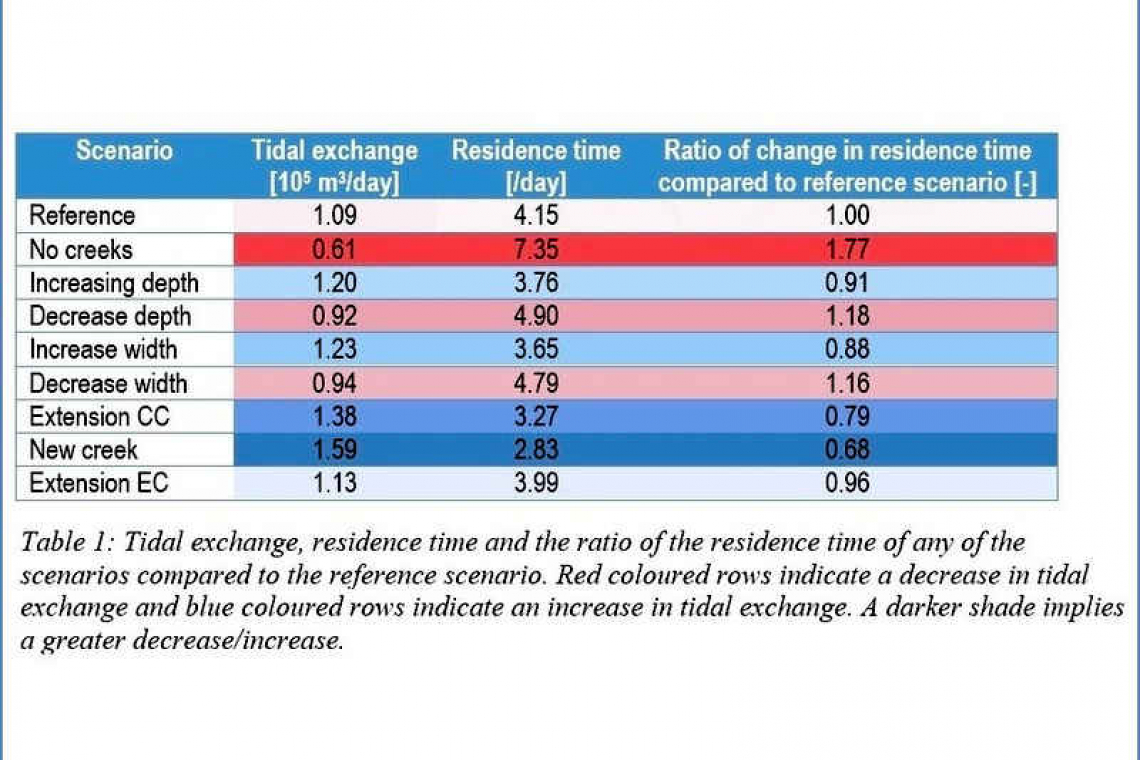By Rob van Zee, University of Twente
The mangrove forest of Lac Bay, Bonaire, is experiencing a die-off of trees in its northern area. Increasing the tidal exchange by creek restoration likely increases the living conditions for the mangrove trees. In the first months of 2022, a collaboration between the Mangrove Maniacs and the University of Twente was set up to investigate the hydrodynamic properties of the area and looked into the effects of creek restoration.
Lac Bay
Mangrove systems worldwide promote ecological diversity while also being economically valuable for humanity. If a mangrove forest experiences die-back, it loses the services it provides. One such case is the mangrove forest of Lac Bay, Bonaire. The northern side of Lac Bay, also known as Awa di Lodo, is experiencing a die-back of mangroves. Unsustainable overgrazing by livestock on Bonaire has depleted the area of ground cover vegetation resulting in the wind, vehicle traffic, and rainwater mobilizing and transporting sediment into Awa di Lodo.
The excess sediment in combination with growing mangrove roots clogs lagoons and creeks, eventually closing off these creeks, reducing the hydrological connectivity between the front and back of the forest. High evaporation rates and a low influx of freshwater create hypersaline conditions in Awa di Lodo. The Mangrove Maniacs are trying to open the mangrove creeks so the tidal exchange (the tide-induced volume of water reaching Awa di Lodo) increases, lowering the salinity values in the area. However, it is yet unclear to what extent the existing creeks contribute to the tidal exchange in Lac Bay and to what extent creek restoration can improve the tidal exchange in Lac Bay.
Research
At the start of the year 2022, a group of researchers from the University of Twente monitored water levels and velocities and mapped topographic characteristics of Lac Bay. One of the goals was to create insight into the hydrodynamics of the mangrove system through in-depth analysis of this data. The propagation of the tidal wave, relations between the water levels and velocities and the tidal asymmetry were investigated. Next, a numerical model was developed to quantify the influence of creeks on the tidal exchange and to investigate the effect of creek restoration on the tidal exchange. To quantify the tidal exchange, the residence time of the water in Awa di Lodo was computed, which is the time it takes (in days) for the tidal exchange to completely replace the total water volume of Awa di Lodo.
Results
The obtained data shows that the diurnal tidal wave has a negligible delay in the open water of Lac Bay. In Awa di Lodo, high water is reached on average more than four hours later than in the open bay. During spring tides, the tidal range in the open water is sufficiently large to create an increasing trend in the water level in Awa di Lodo. The water level in Awa di Lodo lowers again when the tidal range decreases during consecutive neap tides.
Flow velocities in the creeks mainly depended on the water level difference between the open water and Awa di Lodo. Both ebb- and flood-dominant peak velocity asymmetries are observed in the creeks. The observed flood-dominant tidal duration asymmetry in Awa di Lodo indicates that sheet flow during high tides is responsible for the fast increase of the water level in Awa di Lodo while during low tides the creeks are responsible for the outflow.
The hydrodynamic model showed that creeks significantly influence the tidal exchange from the open water in Lac Bay to Awa di Lodo (Table 1). A new creek connection to Awa di Lodo, preferably by extension of the creek through the centre of the mangrove system, is found to be the most efficient to increase the tidal exchange. It was also concluded that the widening of the creeks, deepening of the creeks or the extension of the eastern creek system would have a limited effect on the tidal exchange. Hence creek restoration is shown to be an effective measure to increase the tidal exchange in the mangrove forest of Lac Bay.
Impacts on the future
The data analysis and the developed hydrodynamic model will be important tools for the Mangrove Maniacs to make decisions on where to open new creeks and to study the impact of their work. By having more insight into the hydrodynamics of Lac Bay, the mangrove restoration will become more effective and thus increase the ecological value of the area.
For more information, you can read the full report via the website www.dcbd.nl.
Report published in the Dutch Caribbean Biodiversity Database; shared by BioNews, the newsletter of the Dutch Caribbean Nature Alliance.







